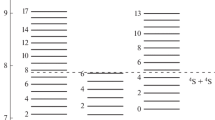Abstract
The luminescence-intensity profiles of the bands of the first and second positive systems of molecular nitrogen were calculated for the case of the precipitation of high-energy electrons with energies from 10 keV to 10 MeV into the atmosphere. The calculations showed that the contribution of the quenching of state B3Πg N2 increases during molecular collisions with an increase in the energy of electrons intruding into the atmosphere. This leads to a decrease in the ratio of the integrated intensities of the bands of the first and second positive systems with an increase in the energy of electrons that precipitate into the atmosphere.




Similar content being viewed by others
REFERENCES
Bazilevskaya, G.A., Kalinin, M.S., Kvashnin, A.N., Krainev, M.B., Makhmutov, V.S., Svirzhevskaya, A.K., Svirzhevsky, N.S., Stozhkov, Yu.I., Balabin, Yu.V., and Gvozdevsky, B.B., Precipitation of energetic magnetospheric electrons and accompanying solar wind characteristics, Geomagn. Aeron. (Engl. Transl.), 2017a, vol. 57, no. 2, pp. 147–155.
Bazilevskaya, G.A., Kalinin, M.S., Krainev, M.B., Makhmutov, V.S., Svirzhevskaya, A.K., Svirzhevsky, N.S., Stozhkov, Yu.I., Filippov, M.V., Balabin, Yu.V., and Gvozdevsky, B.B., Precipitation of magnetospheric electrons into the Earth’s atmosphere and the electrons of the outer radiation belt, Bull. Russ. Acad. Sci., Phys., 2017b, vol. 81, no. 2, pp. 215–218.
Gilmore, F.R., Laher, R.R., and Espy, P.J., Franck–Condon factors, r-centroids, electronic transition moments, and Einstein coefficients for many nitrogen and oxygen band systems, J. Phys. Chem. Ref. Data, 1992, vol. 21, no. 5, pp. 1005–1107.
Heavner, M.J., Morrill, J.S., Siefring, C., Sentman, D.D., Moudry, D.R., Wescott, E.M., and Bucsela, E.J., Near-ultraviolet and blue spectral observations of sprites in the 320–460 nm region: N2 (2PG) emissions, J. Geophys. Res., 2010, vol. 115, A00E44. https://doi.org/10.1029/2009JA014858
Hoder, T., Bonaventura, Z., Bourdon, A., and Simek, M., Sub-nanosecond delays of light emitted by streamer in atmospheric pressure air: Analysis of N2(C3Πu) and \({\text{N}}_{2}^{ + }\)(B2 \(\Sigma _{u}^{ + }\)) emissions and fundamental streamer structure, J. Appl. Phys., 2015, vol. 117, 073302.
Kanmae, T., Stenbaek-Nielsen, H.C., and McHarg, M.G., Altitude resolved sprite spectra with 3 ms temporal resolution, Geophys. Res. Lett., 2007, vol. 34, L07810. https://doi.org/10.1029/2006GL028608
Kirillov, A.S., Electronic kinetics of molecular nitrogen and molecular oxygen in high-latitude lower thermosphere and mesosphere, Ann. Geophys., 2010, vol. 28, no. 1, pp. 181–192.
Kirillov, A.S., Excitation and quenching of ultraviolet nitrogen bands in the mixture of N2 and O2 molecules, J. Quant. Spec. Rad. Transfer, 2011, vol. 112, no. 13, pp. 2164–2174.
Kirillov, A.S., Intermolecular electron energy transfer processes in the collisions of N2(A3 \(\sum\nolimits_u^ + , \)v = 0–10) with CO and N2 molecules, Chem. Phys. Lett., 2016, vol. 643, pp. 131–136.
Kirillov, A.S., Intermolecular electron energy transfer processes in the quenching of N2(C3Πu, v = 0–4) by collisions with N2 molecules, Chem. Phys. Lett., 2019, vol. 715, pp. 263–267.
Kirillov, A.S. and Belakhovsky, V.B., The kinetics of N2 triplet electronic states in the upper and middle atmosphere during relativistic electron precipitations, Geophys. Res. Lett., 2019, vol. 46, pp. 7734–7743. https://doi.org/10.1029/2019GL083135
Kirillov, A.S., Yagodkina, O.I., Ivanov, V.E., and Vorob’ev, V.G., Excitation mechanisms of the 1PG system of N2 in aurorae, Geomagn. Aeron., 1987, vol. 27, no. 3, pp. 419–427.
Konovalov, V.P., Degradation spectra of electrons in nitrogen, oxygen, and air, Zh. Tekh. Fiz., vol. 63, no. 3, pp. 23–33. 1993.
Konovalov, V.P. and Son, E.E., Degradation spectra of electrons in gases, Khim. Plazmy, 1987, vol. 14, pp. 194–227.
Krivolutsky, A.A. and Repnev, A.I., Vozdeistvie kosmicheskikh faktorov na ozonosferu Zemli (Impact of Space Factors on the Earth’s Ozonosphere), Moscow: GEOS, 2009.
Krivolutsky, A.A. and Repnev, A.I., Impact of space energetic particles on the Earth’s atmosphere (a review), Geomagn. Aeron. (Engl. Transl.), 2012, vol. 52, no. 6, pp. 685–716.
Makhmutov, V., Bazilevskaya, G., Stozhkov, Y., Svirzhevskaya, A., and Svirzhevsky, N., Catalogue of electron precipitation events as observed in the long-duration cosmic ray balloon experiment, J. Atmos. Sol.-Terr. Phys., 2016, vol. 149, pp. 258–276.
Mironova, I., Aplin, K., Arnold, F., Bazilevskaya, G., Harrison, R., Krivolutsky, A., Nicoll, K., Rozanov, E., Turunen, E., and Usoskin, I., Energetic particle influence on the Earth’s atmosphere, Space Sci. Rev., 2015, vol. 194, nos. 1–4, pp. 1–96.
Rees, M.H., Stewart, A.I., Sharp, W.E., Hays, P.B., Hoffman, R.A., Brace, L.H., Doering, J.P., and Peterson, W.K., Coordinated rocket and satellite measurements of an auroral event. 1. Satellite observations and analysis, J. Geophys. Res., 1977, vol. 82, no. 16, pp. 2250–2257.
Sharp, W.E., Rees, M.H., and Stewart, A.I., Coordinated rocket and satellite measurements of an auroral event. 2. The rocket observations and analysis, J. Geophys. Res., 1979, vol. 84, no. A5, pp. 1977–1985.
Simek, M., Optical diagnostics of streamer discharges in atmospheric gases, J. Phys. D: Appl. Phys., 2014, vol. 47, id 463001.
Turunen, E., Verronen, P.T., Seppälä, A., Rodger, C.J., Clilverd, M.A., Tamminen, J., Enell, C.-F., and Ulich, T., Impact of different energies of precipitating particles on NOx generation in the middle and upper atmosphere during geomagnetic storms, J. Atmos. Sol.-Terr. Phys., 2009, vol. 71, nos. 10–11, pp. 1176–1189.
Vallance, J.A., Aurora, Dordrecht, Netherlands: D. Reidel, 1974.
Funding
The study was supported by a grant from the Russian Science Foundation (project no. 18-77-10018).
Author information
Authors and Affiliations
Corresponding authors
Rights and permissions
About this article
Cite this article
Kirillov, A.S., Belakhovsky, V.B. Luminescence of Molecular Nitrogen Bands in the Earth’s Atmosphere during the Precipitation of High-Energy Electrons. Geomagn. Aeron. 60, 90–95 (2020). https://doi.org/10.1134/S0016793220010077
Received:
Revised:
Accepted:
Published:
Issue Date:
DOI: https://doi.org/10.1134/S0016793220010077




